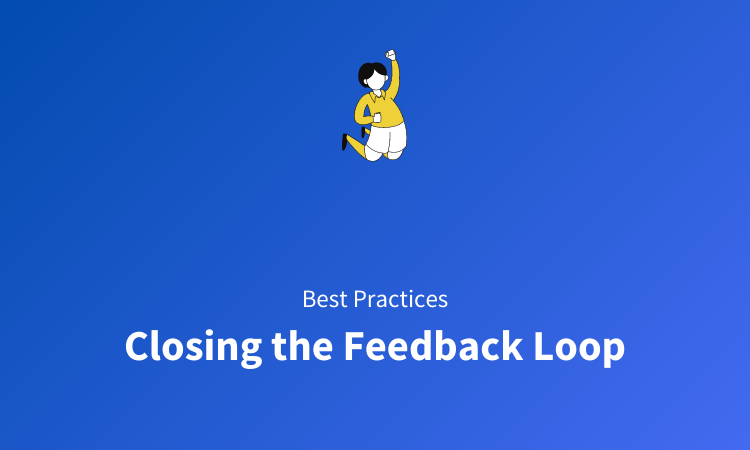You all know that Customer Satisfaction is the core necessity for every organization to have a successful journey. And to know whether the customers are satisfied or not, companies gather Customer Feedback. Even if you do not gather feedback, customers find a way to share it.
They can share their feedback in the form of online reviews which most people trust or they can share it via social media websites. It would be good to know that 67% percent of consumers are influenced by online reviews.
So it is essential to collect Customer Feedback. But if you really want to satisfy customers, merely collecting feedback is not enough. What you need to do is to take appropriate action on it.
This requires you to follow a process called Closing the Customer Feedback loop, which is as important as collecting feedback. Now, if think that sending an automated Thank You message or an email is fair enough, then you are at fault.
You collect feedback through Customer Satisfaction Surveys and use various methods to reach your customers and get it. Don't you think it would be a big injustice with all your hard work and the process of collecting Customer Feedback when you actually don't do anything more than sending an automated email?
Well, we will tell you some of the best practices to be followed to close the feedback loop effectively but firstly, let's understand better what actually this process is all about.
What is Closing the Customer Feedback Loop?
Closing the Customer Feedback Loop is defined as the process of responding to Customer Feedback thereby engaging with your customers regarding their experiences with your brand, product and services. It involves resolving of their issues and concerns and thus ensuring Customer Satisfaction by improving your products and services.
60–75% of customers will do business with a company again if it deals with a customer service issue fairly even if the result is not in their favor. With this fact, you can realize how important this process if for your business.
Closing Feedback Loop effectively requires you to follow some best practices. Let's explore what these practices are and how you can follow them.
Best Practices for Closing the Customer Feedback Loop
- Acknowledge and thank the Customers
- Centralize your Customer Feedback
- Address Immediate Issues first
- Keep customers informed about the progress
- Empathize and apologize wherever required
- Set Customer Expectations about time and action
- Say "No" rather than fake promises
Let's learn how these best practices can be really helpful in Closing the Customer Feedback Loop and thus help in enhancing Customer Satisfaction.
Tip 1
Acknowledge and thank the Customers
The information about the Customers' experiences with your products and services is a real treasure which you are getting in the form of Customer Feedback. So always acknowledge your customers that you have received their feedback and convey them that it actually matters for you and is considered valuable.
Do thank the customers for their feedback. Sending of automated mails and messages can do this work for you, but as stated above also, you need not stop here. This is just the first step in the process of Closing the feedback loop.
Tip 2
Centralize your Customer Feedback
Always keep your Customer Feedback on a centralized location in a well-managed way rather than scattering it across numerous spreadsheets. However, you can group your feedback among various types to create an effective repository for future reference.
There are now good Customer Feedback Software and apps that help you in this purpose. They enable you to know only keep your Customer Feedback safe but also provide make meaningful analysis reports out of them.
Tip 3
Address Immediate Issues first
All Customer Feedback should be responded as soon as possible but there are certain issues which are necessary to be addressed immediately. For instance, you are a company providing IT services to organizations and you have a client which is a bank and its server has suddenly been down.
In such a case, you cannot follow on First come first serve basis and keep addressing other feedback that can be addresses afterwards. You have to address this issue immediately and provide assistance to make the things up and running for the client as soon as possible.
So, you should set such a feedback mechanism that immediate feedback can be addressed first. You should use a good Customer Feedback Software that can help you to do so by providing instant alerts and notifications for feedback and negative feedback.
Tip 4
Keep customers informed about the progress
Don't confine the process of Closing the Feedback loop to just responding to a feedback after getting it or sending a short mail only after completing the required action. You must keep the customers informed as well about the progress of their work.
This will not only assure the customers that their feedback has been taken but also keep their calm and patience alive as they would get to know the progress on each and every step. Whereas, if you start doing work on their feedback which would take let's say a time of ten days, but do not inform them of the progress, these ten days would frustrate your customers even more.
50% of consumers give a brand only one week to respond to a question before they stop doing business with them. So it is better to keep the customers informed about the progress of your actions on their feedback.
Tip 5
Empathize and apologize wherever required
When you see there is some negative feedback from your customers, deal with it empathically. Apologize them for the bad Customer Experience they had with you and ask them where and how things went wrong. Let them open up and tell you what they feel for you an your brand.
Investigate their issues and if you find a fault at your side, never try to cover that up. Rather, accept the mistake, apologize and work immediately on the counter actions required. Even if you find that it was something which was out of your control, empathize with the customers, understand their concerns and try to help them as far as possible.
Keep in mind that the customers remember how you assist them when they need you the most. This increases their loyalty and you are able to even convert your detractors into promoters if you Close the Feedback loop properly.
Tip 6
Set Customer Expectations about time and action
When the customers provide you their feedback, they should be confident enough that their precious time of filling a feedback survey or providing their insights is not wasted. They should know that their feedback is taken care of. For this purpose, companies set up automated emails and messages conveying the gratitude and telling them that their feedback will be taken care of.
But this is not enough. You need to tell them, when you will look into their feedback and by how much time will you respond or fix the things up for them. It is a very good practice to set the right expectations about the time taken to work on a feedback and the actions to be performed on that feedback.
Tip 7
Say "No" rather than fake promises
Every customer is different. Different people perceive your actions differently and so they provide different feedback and a variety of ideas. But you cannot follow everybody's suggestions, can you? So, its okay to say "No" to some of them which don't suit your brand.
It is anyhow much better than giving false hopes and making fake promises to the customers which will break their trust on the brand which is hard to gain. So, its okay to say No. Customers also understand that you cannot implement every idea given by every person.





 iPad Surveys
iPad Surveys Android Surveys
Android Surveys Kiosk Surveys
Kiosk Surveys Mobile Forms
Mobile Forms Email Surveys
Email Surveys SMS Surveys
SMS Surveys Website Surveys
Website Surveys Creating Surveys
Creating Surveys Multilingual Surveys
Multilingual Surveys Collecting Feedback
Collecting Feedback Closing Feedback Loop
Closing Feedback Loop Reporting & Analytics
Reporting & Analytics NPS Dashboard & Reporting
NPS Dashboard & Reporting Multiple Locations & Chains
Multiple Locations & Chains Offline Device Tracking
Offline Device Tracking APIs, Webhooks & Integrations
APIs, Webhooks & Integrations Healthcare
Healthcare Education
Education Retail
Retail Financial
Financial Restaurants
Restaurants Hotels
Hotels Customer Satisfaction
Customer Satisfaction Patient Satisfaction
Patient Satisfaction Employee Satisfaction
Employee Satisfaction Net Promoter Score
Net Promoter Score Website Surveys
Website Surveys Feedback Form Templates
Feedback Form Templates Integrations
Integrations The Ultimate NPS Guide
The Ultimate NPS Guide Survey Tips and Tricks
Survey Tips and Tricks Blog and Insights
Blog and Insights Survey Guides
Survey Guides Help Documentation
Help Documentation Customers
Customers


















